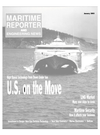
Page 38: of Maritime Reporter Magazine (January 2003)
Read this page in Pdf, Flash or Html5 edition of January 2003 Maritime Reporter Magazine
Australia
Speed to Spare
The Australian marine industry is noted for building large, fast, efficient vessels, primarily for commercial fern- purposes. But as coastal patrol needs grow, so too do the military applications for these amazing breeds. Follow ing is a brief review of some of the recent news from Down Under.
INCAT
Hobart-based shipbuilder Incat is emerging from a challenging year with news of not one, but two orders for the
United States military. Just three weeks after the U.S. Army Tank-Automotive and Armaments Command (TACOM) announced the lease of their first
Theater Support for the Army from
Bollinger/Incat USA. Military Sealift
Command (MSC), Washington. D.C.. also announced a contract for a 322-ft. (98-m) craft from Bollinger/Incat USA. to support U.S. Navy Mine Warfare
Command.
From its inception, Incat has con- structed more than 50 vessels of varying lengths. The company's first passen- ger/vehicle ferry was delivered in 1990. a 243-ft. (74-rn) Wave Piercing
Catamaran with a maximum deadweight capacity of 200 tons. The more recent 98 m Evolution 10B range has a dwt four times that amount.
Incat's shipbuilding activity is con- ducted from a modern facility with more than 32.000 sq. m. under cover, located at Hobart's Prince of Wales Bay.
Recently an additional 17.420 sq. m. under cover building hall was commis- sioned. The new Wilson's dry dock facility has already played host to Joint
Venture (hull 050). Condor 10 (hull 030). Winner (hull 045) and The Lynx (057), all of which returned to Incat to undergo dry-docking and refit.
From a military perspective, the Incat built HMAS Jervis Bay (hull 045). com- missioned into the Royal Australian
Navy in May 1999 for two years to operate between Darwin and East
Timor, highlighted to the world how high-speed, light, multihull craft can be utilized for military purposes.
In 2001 and in response to interest from U.S. forces in high-speed craft
Incat, via its United States affiliate Incat
USA, formed a strategic alliance with an
American Shipyard to market and build for the U.S. military and commercial markets. Impressed with what they saw in HMAS Jervis Bay, the U.S. Military followed suit with Incat's 315-ft. (96-m)
Wave Piercing Sealift Catamaran HSV-
XI Joint Venture (hull 050).
Speaking of Joint Venture's perform- ance in a sealift role, U.S. Navy Admiral
Robert Natter. Commander-in-Chief of the Atlantic Fleet, said recent fleet exer- cises had revealed the craft's military potential. "I think there are all kinds of applications for this kind of a high- speed. relatively small craft," he said.
In addition to sealift. Admiral Natter believes the catamarans could be used for inserting special operations forces along coastal waters, as well as to per- form surveillance and command and control missions. He also singled out the vessel's potential for mine warfare. "I'm convinced, based on our experi- was built by Gladding-
Hearn Shipbuilding.
International Catamaran Designs
Incat Design Leaves
Indelible Mark
International Catamaran Designs (Sydney) (Incat Designs) are marine designers specializ- ing in fast catamarans. The company, whose designs are licensed for construction by two of the pre-eminent builders of fast ferries in the
U.S. — Gladding Hearn and Nichols Brothers
Boatbuilders — boasts an impressive client list who operate some of the more <, efficient and reli- ': , able vessels of this genre in the world. Nichols
Bros. and
Gladding Hearn have each built close to 30 cata- marans, and the company's designs are also built in Australia,
New Zealand,
Singapore, United
Kingdom, Hong Kong, Japan, Canada and Iran.
In 25 years, more than 160 catamarans had been built to their designs, ranging in size from eight to 122 m. The late 1990s, particularly, proved to be a successful period for the com- pany in the U.S., a market that saw more ves- sels built than any other market.
Incat Designs Sydney is perhaps best known for its innovative Wave Piercing Catamaran.
Other developments in hull form have been in the development of the Z-Bow catamaran and recent developments have concentrated on designs of high speed low wash vessels for use in harbors and rivers.
Incat Designs Sydney has a large range of designs covering many sizes, hull configura- tions and vessel uses, and includes: • Lengths from 11 to over 122 m. • Catamarans, Wave Piercing Catamarans,
Z-Bow Catamarans, Low Wash Hulls, Shallow
Draft Hulls and Kitset Packages • Varying Applications - Passenger Services,
Tourist Services, Fast Car Ferries, Cruise
Ships, Patrol Boats, Search and Rescue Craft,
Airport Rescue Craft, Fast Freighters, Pleasure
Craft, Oilfield Supply Craft, Underwater
Research, etc.
Circle 190 on Reader Service Card www.maritimereporterinfo.com
Buquebus Ferry 147 feet - 300 passengers - 53 knots
Alaska Marine Highway System Ferry 240 feet - 250 passengers - 30 vehicles - 35 knots
New York Fast Ferry 124 feet - 350 passengers - 35 knots
New York Water Taxi 53 feet - 75 passengers - 25 knots
New York • Florida • Connecticut www.derecktor.com
NEW YORK WATER TAXI 7.V.V
Circle 218 on Reader Service Card or visit www.maritimereporterinfo.com 38 Maritime Reporter & Engineering News

 37
37

 39
39
